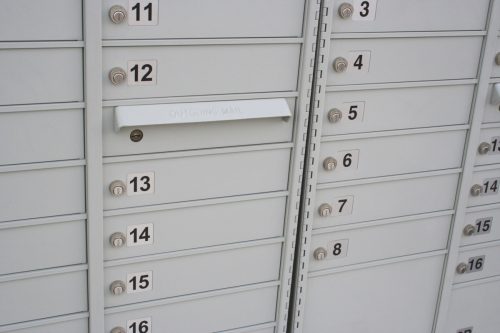USPS Is Making Even More Changes to Your Mail, Starting Jan. 22
The postal agency has plenty of adjustments in store this month.

The U.S. Postal Service (USPS) has been making a number of changes to its structure over the last few years, in large part to climb out of an ever-widening financial hole. Back in March 2021, the agency unveiled Delivering for America (DFA), a 10-year plan created to get the USPS back on solid ground. So far, changes have included adjustments to pricing structures and shipping standards, but the new year is bringing even more updates for customers—and there are some you might not be happy about. Read on to find out about all the changes the USPS is making to your mail this month.
READ THIS NEXT: USPS Is Making These Major Changes to Your Deliveries, Starting Jan. 22.
The Postal Service is raising the cost of PO Boxes this month.

The USPS offers customers the option to secure their personal or small business mail through a Post Office (PO) Box. With this service, you can reserve a locked mailbox at one of the agency's thousands of facilities across the U.S. Of course, this comes at a cost—and that cost is now climbing.
On Jan. 8, EcommerceBytes reported that the Postal Service is raising its rental fee for a PO Box this month. According to the news outlet, the USPS just sent a notice to certain box holders that the new rates would kick in starting Jan. 22. "Fees paid on or after that date are subject to new rates," the agency said.
Rental prices for PO Boxes vary significantly by location, but they can start anywhere from $4.33 to $21.50 a month, depending on the size of your mailbox, with some people paying several times that, according to the USPS. And when the new prices kick in this month, certain customers could be paying as much as $367 for a three-month rental period or $639 for a six-month rental period.
Compared to current prices, this means costs will increase by as much as almost $40 in certain situations.
You can renew now to keep your lower rate.

If you act now, you can avoid the new rates this month. In its notice, the USPS reminded existing box holders on a January schedule that they can renew before the higher prices take effect in two weeks, per EcommerceBytes.
"If your PO Box renewal fees are due in January, and you would like to renew at the existing rate, please visit usps.com/poboxes to renew before Jan. 22, 2023," the agency advised.
This isn't just something those on a January renewal schedule can take advantage of, however. USPS spokesperson David P. Coleman told the news outlet that PO Box renters whose renewal dates come later in the year can also renew now to keep their current rate.
"PO Box payments postmarked before Jan. 22, 2023, will be renewed at the old rate," EcommerceBytes explained.
RELATED: For more up-to-date information, sign up for our daily newsletter.
But that's not the only January price change to be aware of.

It's not just PO Boxes—the USPS is set to make a number of price adjustments this January, some of which have already been revealed. In fall 2022, the Postal Service announced that it had filed notice with Postal Regulatory Commission (PRC) of proposed increases to the costs of its mailing and shipping services for 2023.
The PRC approved a 4.2 percent increase for first-class mail, marketing mail, periodicals, package services and special services on Nov. 28, according to Linn's Stamp News. Changes will also take place on Jan. 22, and will include three-cent increases for the price of First-Class Mail Forever Stamps and domestic letters, as well as a four-cent increase for domestic postcards and a five-cent increase for international postcards and international letters.
Just last month, the PRC also approved price changes for shipping services. This will go into effect on Jan. 22 as well, and overall service prices for Priority Mail will increase by 5.5 percent. Priority Mail Express will increase by 6.6 percent and First-Class Package will increase by 7.8 percent.
The Postmaster General has defended these price increases.

Customers have already been hit with multiple price hikes from the USPS in the past few years—the most recent being a temporary increase during the holiday shipping season. But this is in line with what Postmaster General Louis DeJoy has warned consumers to expect.
Back in August, DeJoy said he believes the agency needs to continue to make "more aggressive" changes to its pricing structure in order to avoid further financial challenges from the impact of inflation.
According to Linn's Stamp News, DeJoy has pushed for a twice-a-year rate increase at the maximum percentages allowed. "The Postal Service has been severely damaged by at least 10 years of a defective pricing model," he told the newspaper. "We need to use our authority to adjust market dominant product pricing as part of our Delivering for America plan to become self-sustaining, as required by law."





















